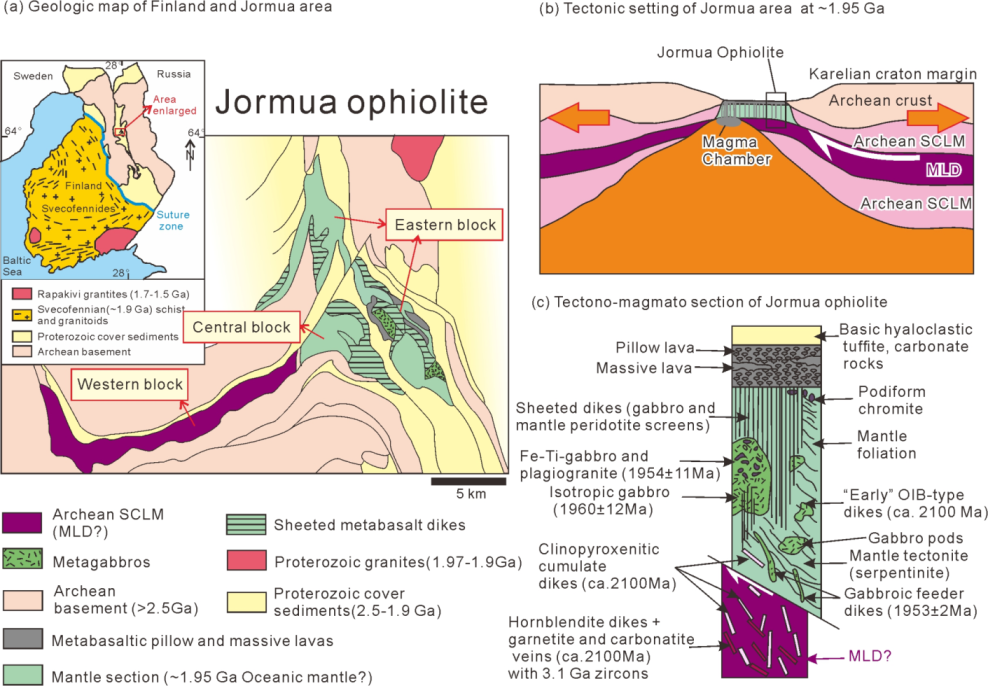CUG scientists, KUSKY, Timothy M. and WANG, Zhensheng, have published three research articles on the Mid-lithosphere discontinuities and the Evolution of the Cratonic Lithosphere in “Geophysical Research Letters” and” Earth Science Reviews”, and caught the attention of domestic and international academic medias.
Mid-lithosphere discontinuities (MLD) are defined as seismically detectable discontinuities at mid-depths of some cratonic lithospheric mantle. The genesis and strength of the MLD are still in debate. Some models suggest the MLD is likely not weaker than the normal lithosphere, whereas other models suggest that some metasomatised MLD rocks are weaker than the normal lithospheric mantle rocks. Thus, the weak MLD is likely a weakly-coupled layer at mid-depths in some cratonic lithosphere blocks, possibly influencing their stabilities.
The CUG scientists accessed the geodynamic significance and features of the MLD during continental breakup and plate motion, and propose a new model that a weak MLD, with lower effective viscosity, can be connected to thinned cratonic margins during the evolution of some cratons and form continuously connected weak zones from cratonic margins to craton interiors, which can lead to lithospheric thinning or removal by extension, basal drag, delamination, thermochemical erosion, and other actions. They think that a weak enough MLD can be deemed as the lower boundary of some cratonic plates, accommodating large displacement between plates and their underlying mantle during plate motions.
The new model gives reasonable explanations of the abnormal tectonic phenomenon that ancient continental cratonic roots are dislocated beneath several oceanic basins and even to form oceanic plateaux. (Wang, Z., Kusky, T., Capitanio, F., 2017. Ancient continental lithosphere dislocated beneath ocean basins along the mid-lithosphere discontinuity: A hypothesis. Geophysical Research Letters 44, 9253–9260.
https://www.researchgate.net/publication/319494410_Ancient_Continental_Lithosphere_Dislocated_Beneath_Ocean_Basins_Along_the_Mid-Lithosphere_Discontinuity_A_Hypothesis)

Figure 1. Displacement of cratonic lithospheric roots beneath oceanic basins.
The model also has applications to understand cratonic lithosphere delamination and recycling, such as in the case of the eastern North China (NCC). (Wang, Z.*, Kusky, T., Capitanio, F., 2018. On the role of lower crust and mid-lithosphere discontinuity for cratonic lithosphere delamination and recycling. Geophysical Research Letters, 45(15): 7425-7433. https://www.researchgate.net/publication/324862111_On_the_Role_of_Lower_Crust_and_Midlithosphere_Discontinuity_for_Cratonic_Lithosphere_Delamination_and_Recycling)

Figure 2. Stages of lithospheric stratification (formation of the MLD) and thinning.
Based on comparisons of different tectonic processes related to the MLD, KUSKY and WANG propose that some samples of weak MLDs can be found in a composite ophiolite profile (Jormua ophiolite) formed on the Precambrian Karelian continental margin, with both continental and oceanic lithosphere, which is supported by chronological, petrological, and structural architectures of the profile. This creates new opportunities to directly study the properties of the MLD, which could help understand and settle the controversies on the origin of the MLD and its physical, chemical, and geophysical properties. (Wang, Z.*, Kusky, T., 2019. The importance of a weak mid-lithospheric layer on the evolution of the cratonic lithosphere. Earth-Science Reviews, 190: 557-569.
https://www.researchgate.net/publication/331107644_The_importance_of_a_weak_mid-lithospheric_layer_on_the_evolution_of_the_cratonic_lithosphere)

Figure 3. Composite ophiolite with an oceanic upper lithosphere and a continental lower lithosphere.